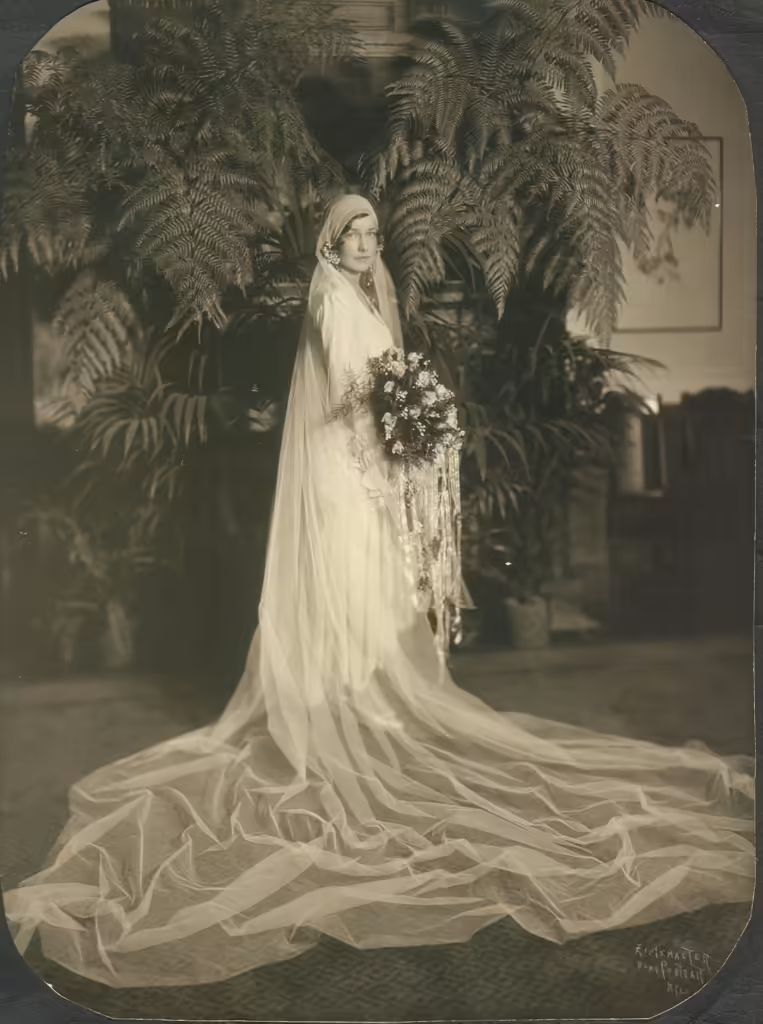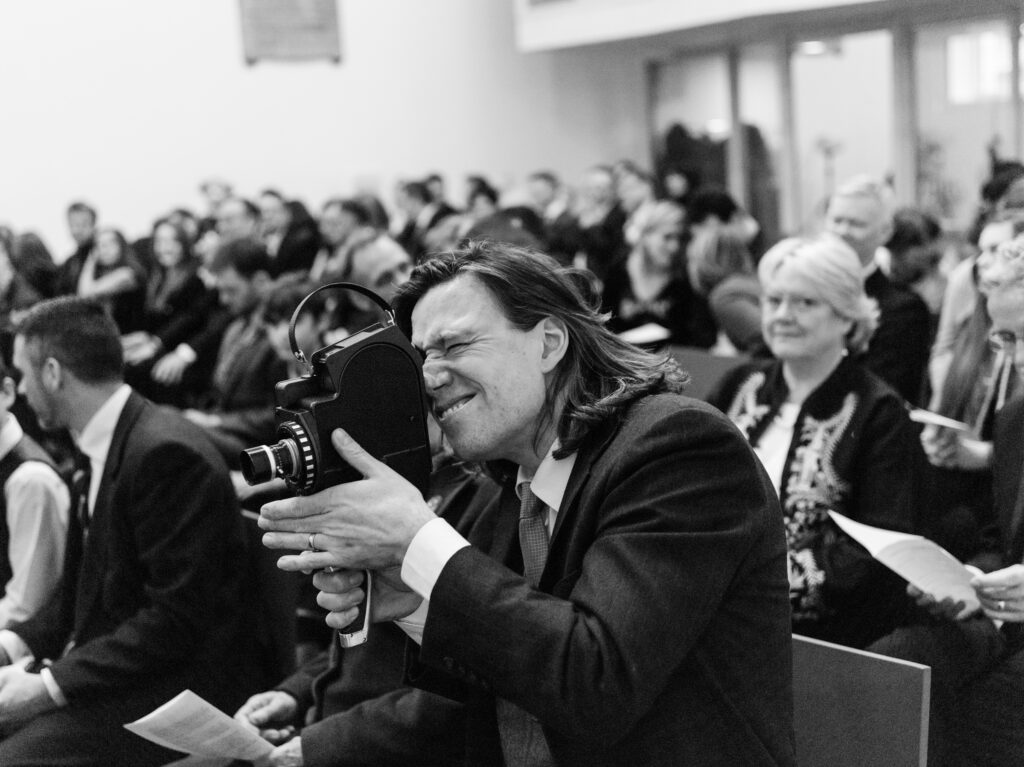As a professional wedding photographer based in Ottawa, I saw a massive shift in the industry from 2020 onwards after COVID-19. However, it wouldn’t be the first time this industry has reinvented itself. So how can a Wedding Photographer be defined today? At its beginnings, wedding photography consisted only of formal studio portraits of the bride, groom, and families. These images were then printed, framed, and collected into family albums. It would be beyond stating the obvious to say that things have changed since the formal photograph below was taken of a bride in 1929 (Source, Wikipedia).
I find this to be a beautiful image and I appreciate how people at this time in history treasured the few photographs they had. However, the general population is now so much more visually literate, photographic equipment has advanced at an exponential rate, and couples have more and want more.
My Focal Encyclopedia of Photography (3rd Edition), published in 1993, more than 60 years after this photo was taken, states that: “The end result of wedding work is the wedding album and, more recently, the wedding video. The album contains a sprinkling of more formalized portraits combined with a chronological coverage of the day’s events. In most cases, the album is a set piece, with certain shots, such as the cutting of the cake, the tossing of the bouquet, and so forth being a requirement. The video follows basically the same script, though…the video generally takes a more candid Cinéma vérité look at the event and may contain interviews, speeches, and other sound bites that bring a real sense of presence to the viewer.

This is a fascinating description for a couple of reasons. Firstly, it speaks of the ‘wedding video’ being a recent introduction. At that time, videos were recorded on VHS or 8mm camcorders. A format that is now redundant and commonly, people will find their VHS tapes have deteriorated over time and can no longer be repaired. This makes me think of the digital age we are in now and how even CDs are rarely used anymore. These storage formats are so risky if you want to keep any kind of data for a significant length of time.
Secondly, the description of the video at the time being more ‘candid’ with a ‘Cinéma vérité‘ style is so similar to the style wedding photographers are shooting in today. Videographers also use this style today, but there has definitely been a noticeable shift towards a less contrived and more candid style of wedding photography in the last two decades.
Why the shift to a more ‘Candid’, ‘Documentary’ style of wedding photography?
To understand this change, we need to also understand that there was a growing shift from film (or analog) to digital photography at this time. When I learned photography at University in the late 90s, I learned all about film, how to process and print black and white, and also colour prints. How to shoot advertising and architectural photographs with transparency film using a large format tilt and shift camera. We had one digital camera on campus that was probably a Canon EOS DCS 3 (something like that, as I can’t remember anymore) and it was really only for use in the studio as the battery life was awful and it was huge and the iso range was something like 100-400. At this time, the best wedding photographers were shooting with medium format film cameras, usually a Hasselblad or Mamiya, and your assistant would be loading in the film on one camera body as you were shooting with another. A large Metz flash would often be used in low-light situations as film stock at the time didn’t have anywhere near the sensitivity of modern-day digital cameras.
Fast forward a decade and digital cameras were significantly more advanced and the knock-on effect of this was that many photojournalists and press photographers began losing their jobs. (This article from 2015 explains why in more detail). Instead of completely switching careers, many of these former newspaper photographers became wedding photographers. As a result, a completely new breed of wedding photographer was born and it changed the industry. It was at this time that I also started shooting more weddings and inspired by this new style of documentary wedding photography, I saw where I could use my own background in documentary and art photography that I had learned at University. As well as the change to digital and a shift in style for wedding photographers, the internet was opening doors to many more amateur photographers who wanted to turn professional, allowing them to learn skills for free from the internet and also promote their business more easily online.
How can a Professional Wedding Photographer be defined today?
If history is any kind of teacher, a professional wedding photographer today (and perhaps anyone in any profession) needs to be ready to adapt. Based on the template from my encyclopedia, this is how I would define a what to expect as the ‘end result’ from a professional Wedding photographer in 2024.

The end result of wedding work is the online wedding gallery and wedding album. The images are individually processed to a high standard by the photographer. The gallery and album contain a sprinkling of more formalized portraits combined with a detailed and candid chronological coverage of the day’s events. Certain shots, such as the cutting of the cake, the tossing of the bouquet, and so forth will not necessarily be a requirement. The images can have a candid, documentary, or editorial look that brings a real sense of presence to the viewer. The resulting images will reflect the personality of the couple.
Additionally, a professional photographer of any kind should master their equipment, and while formal training or membership in a professional organization is not required it is recommended. A professional wedding photographer should use a ‘full frame’ digital camera with professional lenses, however, cameras with smaller sensors in the right hands can produce stunning results.
Finally, one thing has not changed since that encyclopedic definition from the 1990s:
“…a true practitioner must be a photographic jack-of-all-trades. A typical wedding day includes elements of formalized portraiture, photojournalism, candid work, and still-life photography. The photographer must be a diplomat, friend, advisor, mediator, and technical expert, as well as on-the-spot repair-person and stylist. The pressure of getting the job done right is enormous – it is not an event that can be easily replayed for the camera.”
The Focal Encyclopedia 3rd Edition, 1993
Ottawa Wedding Photographer
As an Ottawa Wedding Photographer based in the capital of Canada, I would love to be not only your photographer but also diplomat, friend, advisor, mediator, and technical expert, as well as on-the-spot repair-person and stylist at your Wedding event. Contact me to book a consultation for your wedding today.
